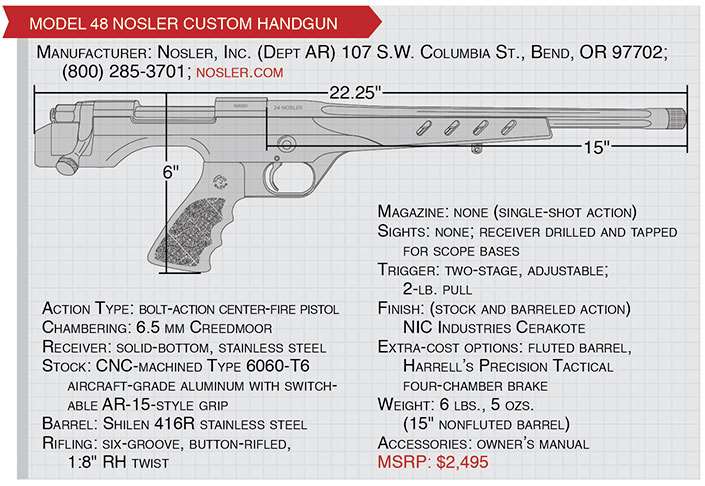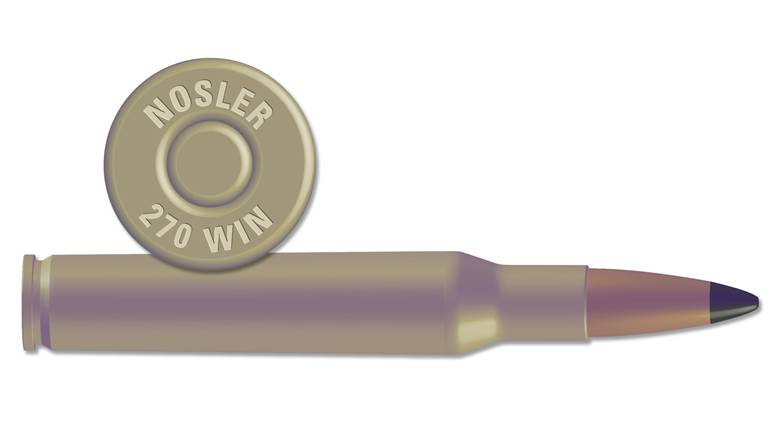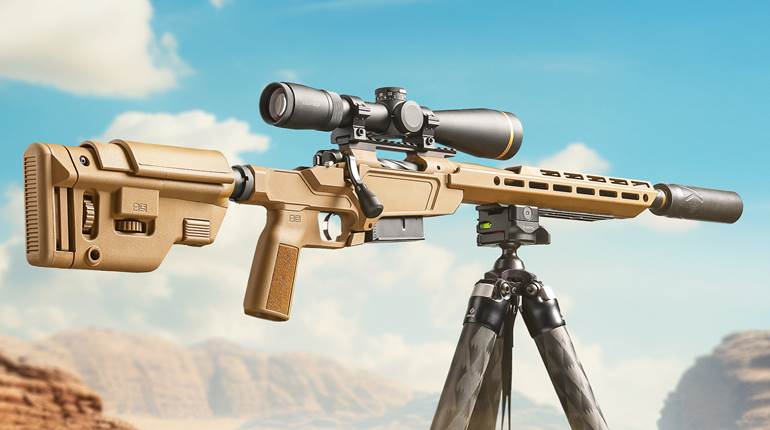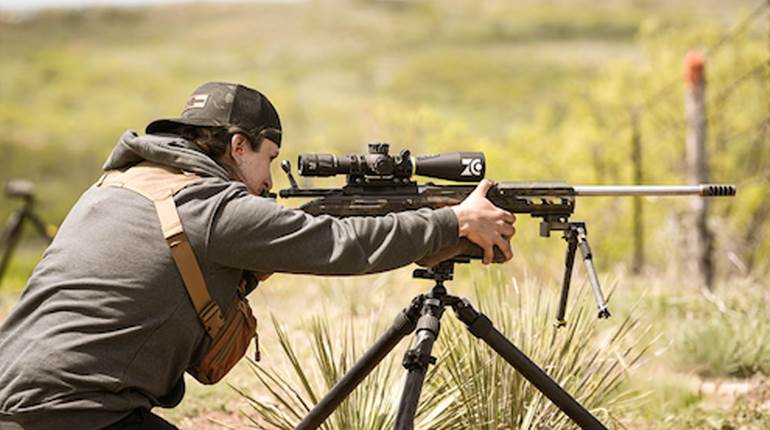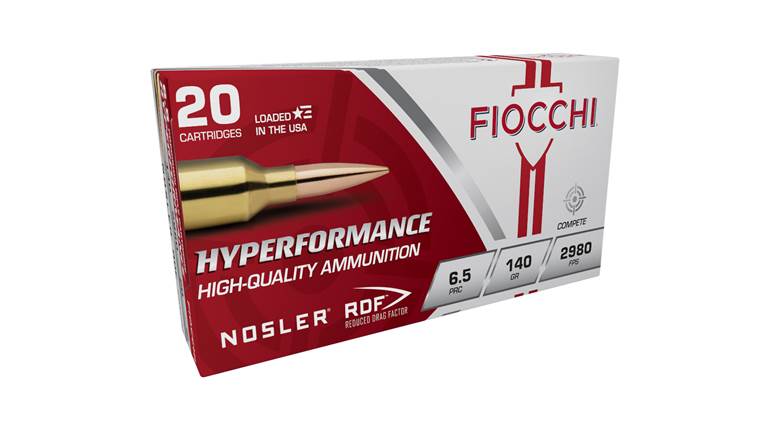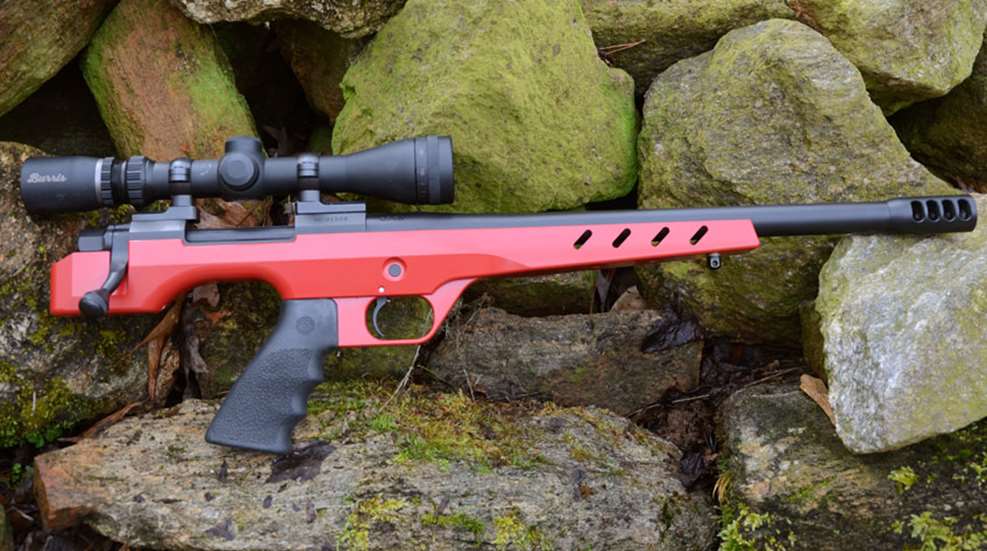
The author tested several factory loads, along with a precision handload, through his own Nosler Custom Handgun, which was factory Cerakoted in Smith & Wesson Red and Graphite Black, and equipped with a Harrell’s Precision Tactical four-chamber muzzle brake. With the Burris 3-12X 32 mm handgun scope shown, it proved capable of half-minute-of-angle accuracy.
Back in 2017, I examined a working prototype firearm hand-built by Mike Lake, senior manager of engineering, research and development at Nosler. It was a long-range handgun built around the Model 48 rifle action, and after Mike had bagged mule deer and pronghorn antelope with the gun, I examined it closely. I was impressed by the design, so it came as no surprise when the company eventually introduced it as the Nosler Custom Handgun (NCH).

Of mid-grip design, the stock is CNC-machined from type 6061-T6 aircraft-grade aluminum bar stock. A black Hogue OverMolded rubber grip with finger grooves is secured to the bottom of the stock with a hex-head bolt and, while it proved to be a comfortable fit with my hand, it is easily switched out for other styles of aftermarket AR-15 grips.
Four large vents in both sides of the forearm allow air to circulate around the barrel. Three holes drilled and tapped into its flat bottom allow an included quick-detach sling swivel post to be installed close to the end of the stock or farther back for attachment of a Harris bipod. Another post at the rear of the stock accepts a single-point carrying sling.
The stock is attached to the action with two hex-head machine screws, one at the tang of the receiver and another just forward of the trigger guard and into the recoil lug.
The Model 48 action is trued in several ways, including the use of diamond paste to hand-lap the dual-opposed locking lugs of its bolt for uniform bearing on their seats in the receiver. The barrel shank threads are machined concentrically with the bolt, and the receiver face is cut precisely perpendicular to the axis of the bolt. The action is a single-shot, and eliminating the magazine cutout in the receiver increases its rigidity.

The match-grade 416R stainless steel barrel free-floats in the stock, and a Lyman digital borescope revealed extremely smooth, hand-lapped rifling. The pre-threaded and contoured blanks are purchased from Shilen and then chambered, fitted and given a 11-degree crown by Nosler technicians. The contour is heavy, with the 15" barrel on my gun measuring 1.160" at the chamber and tapering to 0.845" at the muzzle.
The barrel is threaded at the muzzle with a thread protector included. Barrel fluting and an extremely effective four-chamber brake from Harrell’s Precision are extra-cost options. Seven barrel-length options start at 12" and go to 18" in 1" increments. Chamberings and their rifling twist rates are: 22 Nosler and 24 Nosler (1:8"), 6 mm Creedmoor (1:7.5"), 6.5 mm Creedmoor (1:8"), 7 mm-08 Rem. (1:9") and .308 Win. (1:10").
Remington surprised the shooting world with the introduction of its XP-100 handgun back in 1963, and so it is with Nosler and the NCH. The two guns share similarities, but their designs also differ in several ways. Since both have mid-grip stocks, a way of connecting the forward-positioned finger lever with the rear-positioned trigger assembly of the action had to be devised.
Designers of both guns skinned that cat in the same way by utilizing a long transfer bar to connect the two. The finger lever on the NCH rotates on a cross-pin in the stock, and pulling it draws the transfer bar forward. A transfer bracket at the opposite end of the bar is in contact with two steel pins protruding from the sides of the trigger housing.
When the action is cocked, the sear is supported by the trigger link, and, since the opposite ends of those pins are fastened to it, pulling the trigger moves it from supporting the sear, thereby releasing the firing pin to fire the gun.
Whereas the transfer bar of the XP-100 is attached to the bottom of its receiver, it is housed in the stock of the NCH. That allows the bar to rest beneath the recoil lug of the receiver rather than through a slot in the lug as on the XP-100.
There are other differences with perhaps the most noticeable being barrel diameter and therefore weight. Muzzle diameter of the 15" Remington barrel is 0.570", or 0.275" smaller than the Nosler barrel of the same length.
The transfer bar of the NCH is far from delicate, but if the barreled action is removed from the stock and then reinstalled improperly, the bar could suffer damage. Nosler recommends placing the gun in a padded vise (I stood it upright on a table with a Harris folding bipod attached) and with bolt and stock bolts removed, the barreled action is lifted vertically from the stock with no twisting or sideways pressure applied.
Prior to placing the barreled action back into the stock in the same manner, it is important to make sure the entire transfer bar assembly is fully seated into its channel in the stock and this includes the rear transfer bracket along with the return spring and its nut and washer. With the barreled action properly settled into the stock, a torque wrench with a 3/16" hex bit is used to first apply 45 to 50 in.-lbs. to the front action bolt, followed by 35 to 40 in.-lbs. to the rear bolt.
Of two-stage design, the trigger is fully adjustable. Sear engagement can be viewed through small windows on both sides of the trigger housing, and it is adjusted by turning a screw in the back of the housing. An overtravel adjustment screw protruding inside the trigger guard at the front and upper end of the finger lever is easily reached.
Pull weight is adjustable from approximately 2 to 4 lbs. by reaching through a small hole in the bottom of the stock and turning a screw at the bottom of the trigger housing. I adjusted pull on the test gun to 2 lbs. and remained as happy as could be without touching either of the other two adjustments.
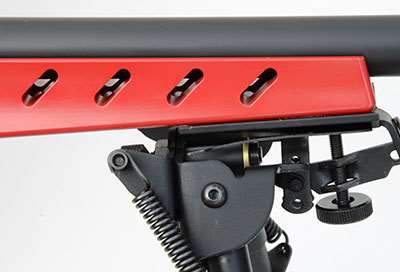
Lake went with a two-stage trigger for several reasons. He wanted to use a cross-bolt safety design to block movement of the trigger lever. He also wanted the sear to be completely disconnected from the transfer bar when the safety is engaged. Another priority was to remove the mass of the trigger lever, transfer bar and other mechanism components from the equation with regard to shock or jarring that could set the gun off.
With the current design, the only mass that could contribute to the gun firing if dropped or jarred is the sear itself (assuming the finger lever is fully released and first-stage clearance exists). Lake considers a two-stage trigger a bit more inherently safe, as it requires a focused and concerted effort on the part of the shooter to take up the slack in the first stage, followed by a slow squeeze to release the second stage.
Positive spring detent pressure keeps the transverse safety in either of its two positions, which is important on a gun to be used for hunting. The thumb and finger can be used together to operate it with very little noise.
I have recommended to Nosler that the safety be made consumer-reversible for left-hand shooters, and my trusty crystal ball indicates that this may eventually happen on future guns. We all know that any firearm is only as safe as the person handling it, and, regardless of design, no safety should be relied on to prevent a gun from firing.
As might be expected, gun weight increases as barrel weight is increased. Nosler rates the NCH with a 12" barrel at 5 lbs., 8 ozs., for fluted and 5 lbs., 14 ozs., for nonfluted. That increases to 6 lbs., 1 oz., and 6 lbs., 12 ozs., for an 18" barrel.
Those are averages and due to a larger hole through its barrel, a gun in .308 Win. will weigh a bit less than one in a smaller chambering. The optional muzzle brake adds about 4 ozs. and increases overall barrel length by 0.750".

The Nosler’s stock and barreled action wear a Cerakote finish, and Nosler increases the fun factor of placing an order by inviting the customer to pick and choose among numerous color options in the library at NIC Industries. My specifications for a red stock and black barreled action bounced back with a request to choose among several different shades of red and black. I settled on Smith & Wesson Red and Graphite Black.
Prior to accuracy-testing the gun I broke in its barrel by cleaning with Shooters Choice powder solvent and Barnes CR-10 copper solvent after each shot. This was concluded when, at the 12-round mark, my Lyman Borecam indicated light streaks of copper fouling had diminished.
After that, the barrel was scrubbed with powder solvent after each five-shot group was fired and 30 rounds later, group size had become fairly consistent. From that point on the barrel was cleaned with powder solvent after 10 five-shot groups had been fired. Copper solvent was used again after as each 100-round mark was reached.
When first shooting the NCH from a concrete benchrest, I attached a Harris adjustable bipod to its front sling swivel post and rested the bottom of its grip on a flat sandbag. Prior to taking a shot, I snuggled the grip into the bag with the horizontal crosshair a bit above my aiming point, gently squeezed the bag to lower the crosshair to dead on the money and pressed the trigger.
Some who buy the pistol will prefer shooting it with sandbags at both ends, so I removed the Harris bipod and shot it over a Sinclair Int’l Heavy Varmint front rest and the rear bags. When shooting groups with the most accurate loads, I found accuracy to be the same, although I did have to concentrate more on avoiding canting the gun than when shooting over the Harris bipod.
I removed the barreled action from the stock and then re-installed it to see if the gun would hold zero. When placing the barreled action back into the stock I settled on 50 and 40 in.-lbs. of torque on the front and rear action bolts, respectively. The gun had maintained its zero perfectly.
The heavier the contour of a barrel, the stiffer it is, and drastically shortening it increases stiffness even more. The barrel of the NCH is both heavy and short, and that pays off in several ways. When shooting groups at 100 yds. with bullets weighing from 120 to 147 grs., there was no difference in lateral group dispersion, and while vertical dispersion was about one-half inch higher with 120- and 130-gr. bullets, all the other weights would have landed in the same group.
During my accuracy tests I allowed the barrel to cool for five minutes between each five-shot group, but average group size increased very little when I tried cooling it every 25 rounds.
My first tests told me how accurate the Nosler pistol can be with factory ammunition, and while the best groups fired were small enough to make many shooters happy, I figured precision handloading along with additional scope magnification would take accuracy to a higher level.
I have never been a big fan of muzzle brakes, but as shooters of custom, heavy-barrel XP-100 pistols long ago discovered, one of the advantages to using a brake is that the drastic reduction in felt recoil allows the safe use of a high-magnification rifle scope with its shorter eye relief when shooting from a benchrest. When shooting the NCH with a firm hold on its grip, the bipod did not lift off the bench and the gun traveled less than an inch to the rear.
Switching out the two-piece base for a Talley Picatinny rail and rings and attaching a Burris Black Diamond 6-24X 50 mm scope boosted magnification and added another 1 lb., 8 ozs., of weight to the gun and that reduced recoil even more.
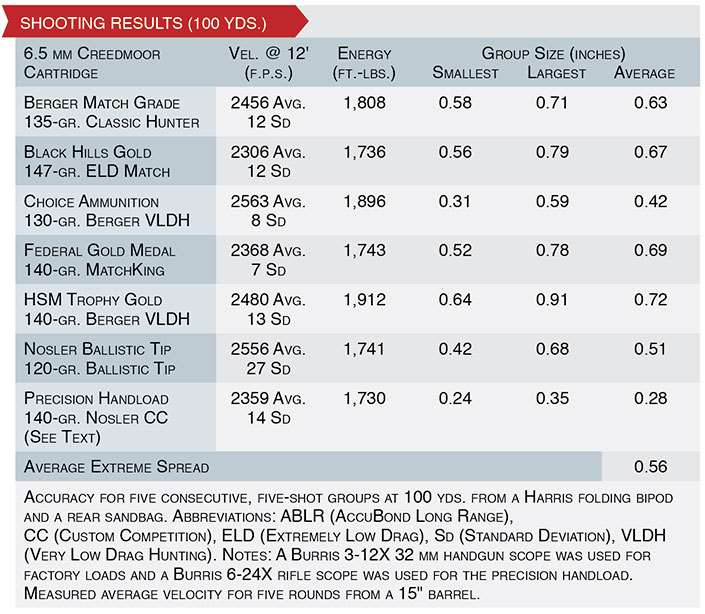
Lapua 6.5 mm Creedmoor cases were trimmed to the exact same length and their mouths chamfered and deburred. Cases were then sorted by capacity and their necks outside-turned to 0.291" (with bullet seated) which was just enough to uniform neck wall thickness. Primer pockets were uniformed, and flash holes were uniformed and deburred.
Powder charges were weighed with a RCBS Model 304 scale and RCBS Gold Match dies were used in a Corbin CSP-1 bullet swaging press converted for ammunition loading. A 0.289" bushing was used in the RCBS neck-resizing die.
Prior to being seated, all bullets took a trip through a Bullet Sorting Stand from Sinclair Int’l. Powder charge weight and bullet jump were adjusted until the Nosler pistol’s accuracy sweet spot was found. Federal GM205M primers were used.
As it turned out, a propellant/bullet combination that delivers sub-quarter-minute accuracy in my 17-lb. target rifle in 6.5 mm Creedmoor worked quite well in the Nosler pistol. That rifle prefers 39.4 grs. of H-4350 with the Nosler 140-gr. Custom Competition bullet seated for 0.025" of free-travel. The Nosler handgun delivered its best accuracy with 39.8 grs. of H-4350 and the 140-gr. Custom Competition seated for 0.010" of jump.
Functioning and feeding of the NCH are bobble-free; simply toss a cartridge through the ejection port, push the bolt home, take aim and squeeze the trigger. Cycling the bolt of a rifle usually takes minimal effort when the forward hand is used to pull the rifle firmly against the shoulder.
This is not possible with a long range-pistol, so leverage required to rotate its bolt from the locked position is gained by placing the thumb against the cocking piece of the bolt or, as I prefer, atop the rear scope-mount ring while using two fingers to lift the bolt handle. It also helps to apply a light coat of gun grease to the firing pin cocking cam surface of the bolt each time the gun is cleaned.
Applying dabs to the rear surfaces of the locking lugs doesn’t make bolt lift easier, but it does prevent locking lug galling in any bolt-action firearm. RIG gun grease from Birchwood-Casey is excellent for this.
Overall workmanship exhibited by the Nosler Custom Handgun is superb, and shooting it proved to be a pleasure. It’s hard to imagine a better example of its type, particularly when accuracy is taken into account. Altogether, the Nosler NCH sets a new standard for the large-format bolt-action hunting handgun.
